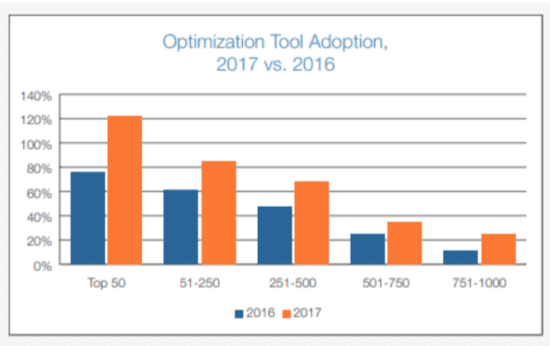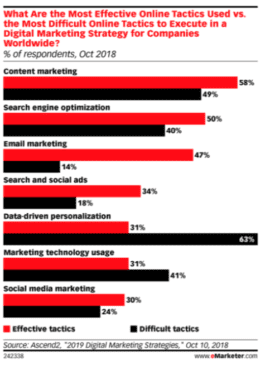Testing and personalization techniques are gaining steam with marketers, as the value they drive becomes tangible through more effectively allocated marketing budgets, better-informed creative, and smoothed-out customer journeys that foster higher conversion rates, but also loyalty.
Last year’s report, State of Digital Marketing Analytics in the Top 1000 U.S. Internet Retailers, showed that testing, personalization and optimization tools had attained “universal” status within the top 50, and made rapid gains in market share across all segments, as shown below:

There are several tools leading the testing and personalization space, including Adobe Target, Google Optimize/ Optimize 360, Optimizely Web, Monetate, Evergage, Certona, and more.
I’ve built out some common use cases, with some highly recognizable Martech stacks, that may help you gain clarity on which tool is right for your unique business.
Use Case #1
- Google Analytics is the primary tool of record
- Testing program is new or early in development (<5 tests being run concurrently)
- Primary test methods are A/B and MVT
- Business objectives are to prove value, prove value through building case studies, informing marketing spend for conversion rate optimization (CRO)
Recommended tool: Google Optimize Plug and play with current Google Analytics implementation will allow for a quick start with little to no development effort
- There’s a free version and it doesn’t cap traffic levels
- All custom dimensions, metrics, or goals currently in existence can be used for testing immediately
- Reporting is seamless from Optimize to Analytics, and additional segments or dimensions can be layered on results for further learnings
- Robust visual editor
- Optimize UI reporting includes advanced statistical modeling, easy to understand read outs on test performance to ensure test integrity
- Native Adwords connections at the campaign, ad group, ad, kw and creative level
- Native connection to Google Tag Manager, enabling business users to control tracking without always needing additional dev support
- Server side implementation options
- Test data can be analyzed via Google Analytics custom reports, Advanced Analytics, segments, Data Studio, Big Query
- Google is investing in new features, including more complex personalization options for future program requirements
Use Case #2
- Google Analytics or Google Analytics 360 is the primary tool of record
- Dedicated site optimization resources and budget
- Test velocity exceeds 5 tests running concurrently
- Moderate to heavy utilization of Google Audiences for marketing
Recommended tool: Google Optimize 360 The paid version includes all features as the free version
- CRO team can run more than 5 tests concurrently
- Increased # of KPIs or goals to track against for the test
- Google audiences can be used for targeting (big feature)
Use Case #3
- Adobe Analytics is the primary analytics tool of record
- Dedicated site optimization resources and budget
- Testing needs include A/B, MVT, or rules based segment personalization
- CRO program maturity can span beginner to intermediate/advanced
Recommended tool: Adobe Target Standard Custom Integration options within Adobe Suite Ie: Adobe Analytics, Launch (Adobe TMS), Campaign, Adobe Audience Manager
- No limits on concurrent tests, but capped to 20 live audiences for targeting purposes
- Adobe Analytics dimensions, segments, audiences, goals, events or evars can be used as targeting criteria for a test
- Robust visual editor
- Greater flexibility to manage test collisions than Google Optimize
- Technical support and documentation is more readily available for Target than Google Optimize
- Auto-allocate ML capability while tests are live, optimizing as the test runs
- Reporting UI of Target less intuitive and usable than Google Optimize, therefore Adobe Analytics is the primary reporting tool.
Use Case #4
- Similar to #3 with the following inclusions:
- Testing needs also include an algorithmic recommendations engine and AI based personalization features for rule building
- Additional investment integrating DMP or CDP and CRM.
- Organization has a clear segmentation strategy
- Dedicated FTE resources to manage the tool
Recommended tool: Adobe Target Premium Includes everything in Adobe Target Standard
- Also has a recommendations engine (ML capability to display various content based on look-alike behavior. Best use case is for ecommerce product recommendations
- Has an algorithmic approach to personalization, testing various alternatives similar to an MVT in an automated fashion
- Improved native app testing capabilities
Use Case #5
- You’re using either Google Analytics or Adobe Analytics as your primary analytics provider
- Your CRO team already has experience already working with Optimizely
- Needs include turnkey integrations with analytics, click tracking, heat mapping, VoC, session replay, and other 3rd party partnerships Optimizely has built
- Ala cart features can be added at incremental price points, whereas Google Optimize and Target only have 1-2 pricing tiers
Recommended tool: Optimizely Web Many more 3rd party integrations with smaller tech providers can be integrated without always needing development resources
- Program management product features are unique to Optimizely, assisting in the project management and collaborative processes in testing
- They have a unique stats engine, that predicts winning treatments sooner than most
- Training material, certifications, and support documents are all readily available when questions arise
- Depending on the package, Optimizely can manage complex personalization tests browser side, server side, and across devices and channels.
- Extra care is required in selecting the appropriate package so as not to risk billing overages or missing features.
While testing & personalization is top of mind for many marketers, 63% say it’s “difficult”.

Of course, simply implementing a tool doesn’t mean the challenge has been met.
For organizations new to the world of testing and optimization, a variety of challenges will come up.
- Steering clear of a “piecemeal” approach to testing, in which tests – successful or not – are largely random, and not part of an overall strategy.
- Convincing busy stakeholders to move beyond past experiences and “gut feel” to create data-informed hypotheses, build new creative to test, and perform rigorous analysis of test results – and proving that it’s all worthwhile
- – Who should own the testing platform? Who decides which ideas get tested, and which never see the light of day?
Selecting the technology that’s right for your business, combined with the ability to address these challenges, and create a culture of testing and personalization, will be a major part of achieving business value.
Learn more about ways to ramp up your testing and personalization strategy with this on-demand webinar: 5 Personalization & Testing Strategies to Upgrade Your Customer Experience


















